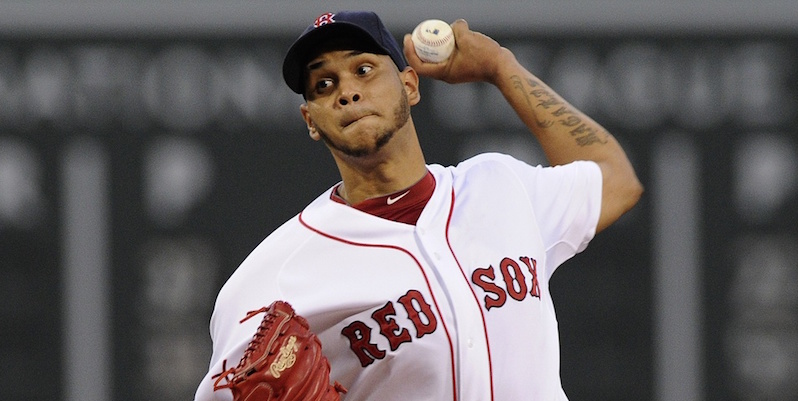You don’t need me to tell you how awful the Red Sox rotation has been this season. Boston fans have endured more mediocre outings than they’d like to remember at this point, and Justin Masterson hasn’t even made a start for the team since early July.
Through Wednesday, the club’s starters have posted the second-worst ERA in the American League. During long stretches of the season’s first half, no Red Sox pitcher seemed capable of escaping the fifth inning. That Boston’s staff-wide FIP of 4.05 suggests some poor fortune has been involved provides little consolation for an organization that’s endured yet another disappointing campaign.
The worst part of all this is how nearly everyone saw these struggles coming. The Red Sox entered the season with a rotation that looked inadequate on paper and has proven to be just that in reality. Although the offense’s underperformance deserves a large piece of the blame pie, Boston was going to be hard-pressed to contend with such a woeful rotation.
Much like last winter, the predominant storyline surrounding the Red Sox this offseason will be the team’s need to add a frontline pitcher to an otherwise subpar staff. And with the hiring of Dave Dombrowski to run the show in baseball ops, many expect Boston to be aggressive in pursuing a top-level arm.
While adding an ace should be a big priority for Dombrowski, the club’s rotation outlook for 2016 might already be rosier than many realize. Since the All-Star Break, Red Sox starters have compiled a 4.30 ERA and 4.29 FIP, both of which rank right near league average over that time span. This performance has come without the benefit of a healthy Clay Buchholz, who was pitching like an All-Star before he landed on the DL.
Boston’s staff has improved, in large part, due to a quietly strong second half from Wade Miley. The southpaw has a 3.25 FIP dating back to the All-Star Break, with a 20.1% strikeout rate and 6.1% walk rate. After an up-and-down start to his Red Sox career, Miley has pitched like the steady mid-rotation hurler the team traded for last offseason.
Even more intriguing has been the midseason arrival of two promising left-handers to Boston’s rotation. Neither Eduardo Rodriguez nor Henry Owens can be considered anything close to a finished product, but both have flashed loads of potential to begin their major league careers. Rodriguez appears more polished at this point, and with an average fastball velocity of 94.8 mph, is one of the hardest-throwing lefties in the game. He’s allowed two earned runs or less in 13 of his 18 outings this season, though his performances in those other five starts are certainly less worthy of praise.
Owens remains very much a work in progress, but he has the raw ingredients to succeed in MLB. The tall left-hander has command issues that need fixing, yet unlike most young starters (Rodriguez included), Owens has four solid pitches with which he can attack hitters. That he has shown the ability to succeed against good offenses is encouraging, even if there are growing pains ahead.
Perhaps the most significant development has been how well Rick Porcello has pitched since his return from the DL. With Boston in line to pay Porcello $82.5 million over the next four years, the club will need to get the right-hander back on track sooner rather than later. While he’s made just three starts since returning, Porcello has looked dominant in that stretch, striking out 22 batters and walking only three in 22 innings pitched.
You can argue all day about whether Porcello’s contract was an overpay, but throughout his career, he’s resembled an above-average starter far more often than the pitcher who posted a 5.81 ERA over this season’s first three months. That he’s decided to re-incorporate his sinker can only be good news for the Red Sox.
And finally, let’s not forget Joe Kelly, who must at least be giving Dombrowski some food for thought with how he’s pitched over the last six weeks. Even if his future is still likely in the bullpen, Kelly has looked the part of a back-end starter for a good chunk of the second half now.
Given all these positive outcomes, Boston’s staff has the potential to be much better next season than it performed in 2015. If Buchholz can recapture the form he showed when healthy this year, he’ll be another piece to add to the starting rotation puzzle that’s a little more crowded than one might expect.
To be certain, the Red Sox can’t enter 2016 and expect to contend without acquiring a reliable starter. There remains plenty of risk with this current group, even if the upside is much greater than what Boston entered this season with.
Buchholz can’t be counted on for 180 innings. Owens and Rodriguez have more potential than the likes of Allen Webster, Rubby de la Rosa and Anthony Ranaudo, but both still have tons of adjustments to make. Although Porcello and Kelly have performed well over small samples recently, their output on the whole this year has been woeful.
Nevertheless, the team can realistically hope for some internal improvements in the rotation in 2016, beyond whoever they obtain this offseason. Acquiring an ace would go a long way toward strengthening the Red Sox’s credentials, but consistency from the rest of the starting staff will be paramount if Boston wants to contend next season.
Photo by Bob DeChiara/USA Today Sports Images
